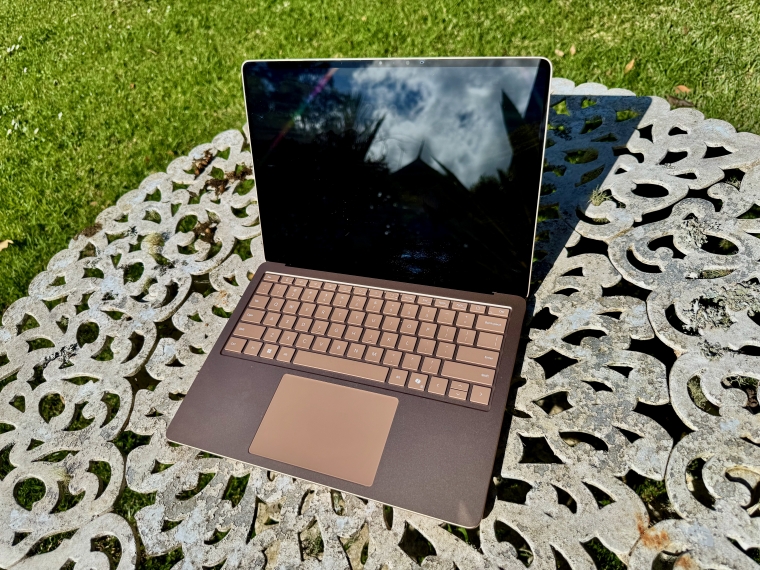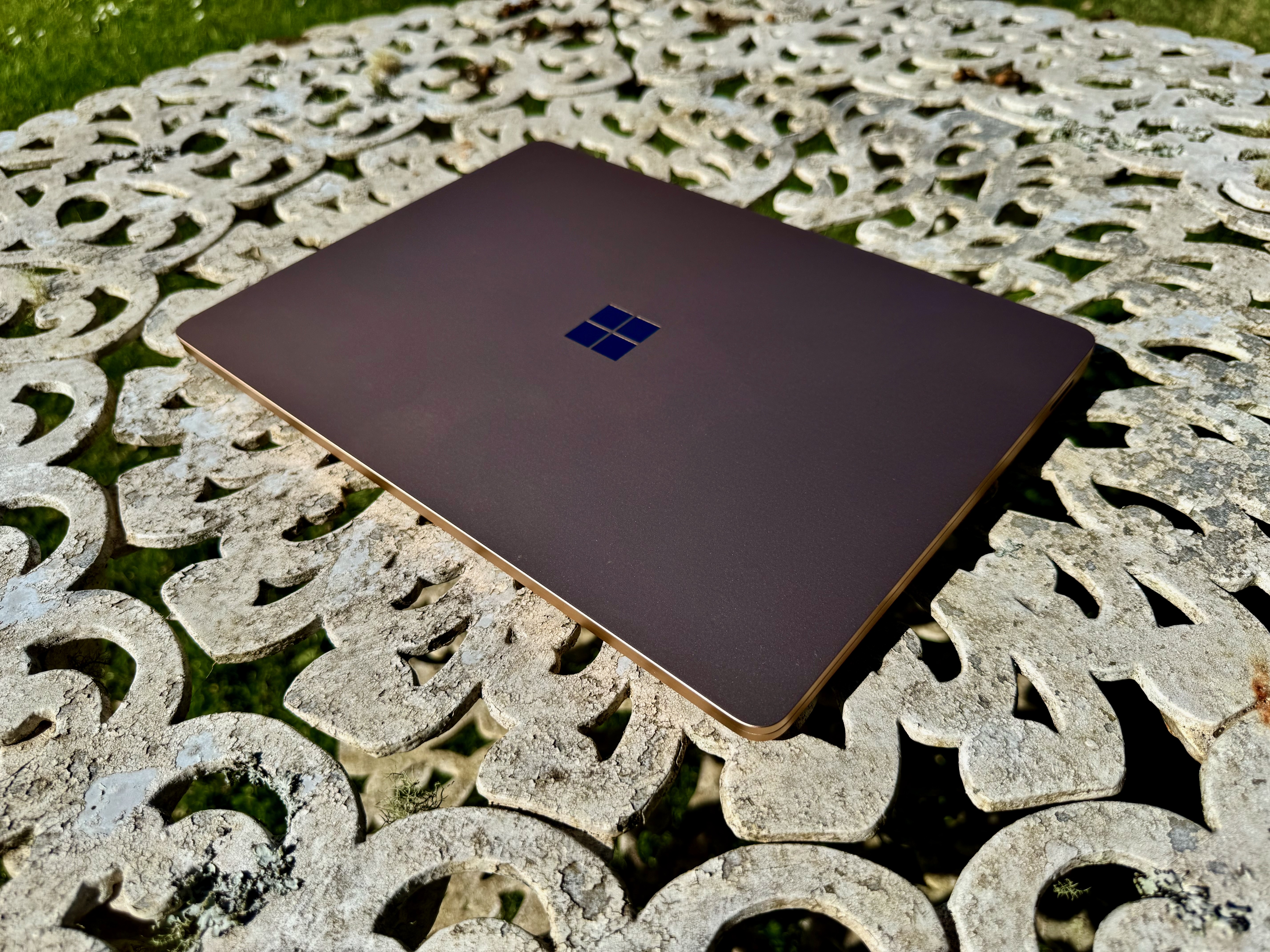
People tend to think of Microsoft as a software company foremost, but it’s worth remembering that the tech giant produces some rather nice hardware as well. Like the lengthy named Surface Laptop 7th Edition for example.
We were sent a 13.8-inch review machine with 16 gigabytes of memory and 512 GB of storage, costing $2849.00 including GST.
That’s not a bad price all things considered, but as a mobile and remote worker, upping the storage to at 1 terabyte which adds $350 would be on the wish list. Maxed out with 32 GB and 1 TB, the Surface Laptop 7th Edition costs $3899.00 including GST.
Like most new mobile devices, you can’t upgrade the components inside the Surface Laptop after purchase so figure out what you need before ordering.
Two USB-C ports, one USB-A, 3.5 mm headphone jack, and that proprietary magnetic Surface connector for charging the laptop are included. The Surface Laptop can charge via the USB-C (or USB4, Type C to be pedantic) ports as well. The USB-C ports are the combo variety and can be used for Thunderbolt docks and external displays - a single display at 5K resolution, and dual at 4K with 60 Hz refresh rate max.
Microsoft is a not so secret admirer of Apple hardware, but it’s also a competitor for the Cupertino company. The Surface Laptop 7th Edition is very much pitched as a competitor to the MacBook Air M3, and it’s a worthy one too.
It sets the minimum standard for Microsoft’s hardware partners.
The Surface Laptop is a premium quality machine, with a great resolution and high dynamic range display that has touch operation, which Apple doesn’t provide for any of its laptops. How touch fits with a typical laptop design that has a physical keyboard depends on the user in question, but it’s kind of cool that you can use your fingers on the screen as well as a mouse. The display has variable refresh rate, from 24 Hertz to 120 Hz, which is better than the 60 Hz on the MacBook Air M3.
Speaking of the (big) trackpad and keyboard, they are both nice to use. For someone who writes as much as yours truly, excellent input devices are a super high priority. Apple’s trackpads on MacBooks are a bit better than the one on the Surface Laptop, but the latter’s absolutely fine.
And… there are no ugly vendor logo stickers to peel off on the palm rest! Windows computer makers, take note.

It’s a Windows laptop, but with Arm inside
My apologies for not being able to think of a fun pun on ye olde Intel Inside slogan replaced by Arm Inside something-something, but on the chip side of things is where the Surface Laptop 7th Edition breaks from the past.
Like Apple, Microsoft is keen on processors designed by Britain’s Arm. The long story short here is that Arm-designed processors are energy efficient yet powerful. This is why you’ll find them in smartphones and tablets everywhere, and now, laptop computers.
Why would you care about some electronics inside the Surface Laptop that you can’t even see? If you want a laptop that’s about as quick as what Apple offers, but doesn’t run hot and provides great battery life - the Surface Laptop will easily go through an entire working day and then some - you will be interested in an Arm-based device.
The sleep mode in the Surface Laptop (when you close the device instead of turning it off) is very good, and it hardly loses power when not in use. The chipset has built in Wi-Fi 7 support, and connects at very high line speeds, over 2 gigabits per second.
Microsoft decided to go with chip maker Qualcomm and the Surface Laptop 7th Edition we had has a Snapdragon X Elite X1E80100 processor with 12 cores and built-in graphics. In other words, not Intel, nor AMD, the traditional Microsoft hardware partners.
It’s safe to say Apple is keeping a very close watch on the new Qualcomm chips. Three years ago, Qualcomm bought a company called Nuvia for a stonking US$1.4 billion. Nuvia isn’t just any old chip designing outfit. It was set up five years ago by former Apple employees, the one that designed the M-series processors you find in current Macs.
Whereas earlier Arm-efforts by Microsoft have been lacklustre, the Snapdragon X chips look good.
Apple’s MacBook Air M3 is still a bit faster, less than 10 per cent on a single core basis, but with four more cores, the Qualcomm Snapdragon X processor revs it up for a 20 per cent lead. The storage subsystem in the MacBook Air on the other hand is 20 to 30 per cent faster than the Surface Laptop, but long story short, both perform really well.
Will that Arm chip run my software?
Without going into too much hairy technical detail, moving from one hardware architecture to another is really difficult for software developers.
There were issues in the earlier Microsoft efforts. This time though the Windows on Arm (WoA) effort is much better than in the past. Yes, there are some applications that won’t run, like the Google Drive app and a number of games.
The list is shrinking however, and you can find browser-based workarounds for many apps that don’t run natively on Windows 11.
It is a consideration for some users, possibly more so for enterprise applications that can be slow to be updated so check what you work with before going down the Windows on Arm route.
That said, there is x86 emulation available in Windows on Arm, so compatibility is pretty good and unlikely to be a concern.
What’s more, if the Arm move gives Microsoft an excuse to clear out decades-old crud in Windows, and by $DEITY there’s a lot of that left even in the latest Windows 11, everyone wins.
Built-in Copilot+ AI feels underdone
All right, so the move to Arm chips from Qualcomm is in the right direction but Microsoft’s taken it a step further: the Qualcomm Elite X has a neural processing unit (NPU) on the chip, capable of 45 trillion operations per second (TOPS). This enables what the cool kids call Edge AI as in running the technology on your device rather than in a data centre somewhere, via the Internet.
You’ll now ask what is measured by TOPS, and Qualcomm has an answer for you. That’s a complex way to say the more TOPS, the faster and better the inferencing experience of the device in question. However, Qualcomm qualifies that with:
“After all, a high TOPS number alone does not guarantee optimal AI performance; it’s the culmination of various factors working in tandem that genuinely define an NPU’s prowess.”
Ah well: either way, if counting TOPS, the NPU in the Qualcomm processor is quite a bit quicker than the Neural Engine part in the Apple Silicon M3 processor. The latter is a 16-core part, rated at 15.8 TOPS.
The Geekbench AI 1.0 performance evaluation software from Primate Labs runs through some typical artificial intelligence tasks like image classification and seems to bear out what Qualcomm said. The AI benchmark provides three metrics, single precision, half precision and quantised score. The baseline system is an Intel Core i7 10700 which scores 1500 and the scoring is linear so double the number, twice the performance.
It scored the Surface Laptop like this:
2248 10828 21653
In comparison, the MacBook Air M3 managed these numbers:
4156 25013 27995
The scores for a MacBook Pro M3 Max were just a small amount higher than the MacBook Air M3; the MBP uses the same NPU as the Air.
You could see Geekbench AI prod the Qualcomm Hexagon NPU into action in Task Manager (a very useful Windows tool that displays various system performance metrics). Apple has yet to add the Neural Engine to the macOS Activity Monitor.
Either way, it’s not worth reading too much into the figures above at this stage. They’re likely to change as operating system updates fine tune the AI/ML hardware usage.
What can you do with Copilot+ then? The big feature, Recall, was put on ice by Microsoft after running into a wall of controversy, with security experts saying it’s not safe to use a feature that takes screenshots of your desktop regularly, and stores these in a database on your computer. Recall will be re-released (!) in October by Microsoft, for users who have signed up to the Windows Insider early preview programme.
There’s a Cocreator button in the MS Paint program that you can experiment with, and see how it makes the NPU performance monitor graph spike as you ask it to generate images locally. Cocreator is apparently the OpenAI DALL-E 3 image generator integrated into MS Paint.
And, it’s a weird concept. You enter a prompt as per DALL-E, such as “generate an image of happy dog”, and then start drawing. As you scribble in MS Paint, Cocreator generates an image of a happy dog. Why do it like that though, and not keep it simple with a text prompt and no drawing required? You can always take the happy dog picture and load it into MS Paint later for tweaking.
Cocreator is not for the paranoid either. You have to have an active Internet connection to use it because Microsoft checks what you generate with Cocreator to make sure it’s safe. No pics of Donald Trump or Joe Biden are allowed for example. Also, there’s a more complex question around whether or not your Cocreator generated artwork is copyrightable - probably not, but it’ll require Big Lawyers tearing into each other in court to decide.
Using the AI for Windows Studio effects like camera tracking of users, a limited set of creative filters and .. is handy, but not exactly earth shattering.
The Copilot+ on-device AI works with Adobe products, some of which are not yet ported to Windows on Arm.
Automatic super resolution for gaming would be interesting to try out: it lowers the screen resolution to bump up frame rates, and then uses local AI to improve visual quality. Sadly, I didn’t have any suitable games for Auto SR, and will need to park that for later. https://www.worksonwoa.com has a list of games that work with Auto SR.
But, there’s no AI-powered Cortana (the Windows equivalent to Apple’s Siri), generative AI for summarisation and text creation yet. That’s bound to arrive and of course, you can head to Microsoft’s web-based Copilot for GenAI jollies meanwhile.
The Edge AI via Copilot+ is very much a first effort and likely to get more elaborate at a later stage. Microsoft needs to watch what it’s doing and remain focused here, as it gets confusing to deal with Copilot+ (Edge AI), and Copilot in an app on Windows 11, and on the web, and in applications, and so forth.
Ultimately, you’d buy the Surface Laptop 7th Edition for its great design and hardware rather than the AI features. It’ll be interesting to see where Edge AI on Windows goes, particularly when it becomes possible to make large language models like Meta’s Llama 3.1 locally with NPU support, which is work in progress currently.
If you’re after a premium portable computer that matches Apple’s offerings, and adds its own unique features, the Microsoft Surface Laptop 7th Edition should be on your list of devices to check out.
Update I was wrong about non-upgradeability. You can pop in a bigger NVMe M2 Gen4 drive for the Surface, fairly easily too.
1 Comments
Can't run Google Drive? That would be a hard pass for many users. Using it in a browser or emulator wouldn't cut it.
It's 2024. I've done some coding. Google should be able to just recompile for the new target CPU. There seems to be plenty of development tools (compilers, debuggers etc.) for ARM chips.

We welcome your comments below. If you are not already registered, please register to comment
Remember we welcome robust, respectful and insightful debate. We don't welcome abusive or defamatory comments and will de-register those repeatedly making such comments. Our current comment policy is here.